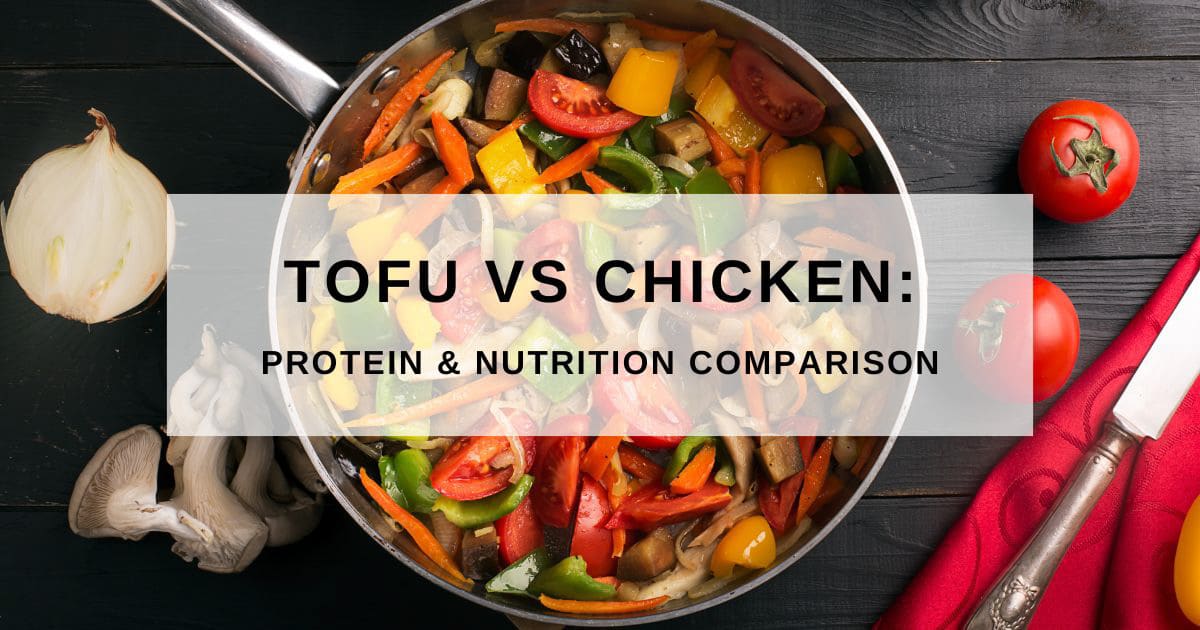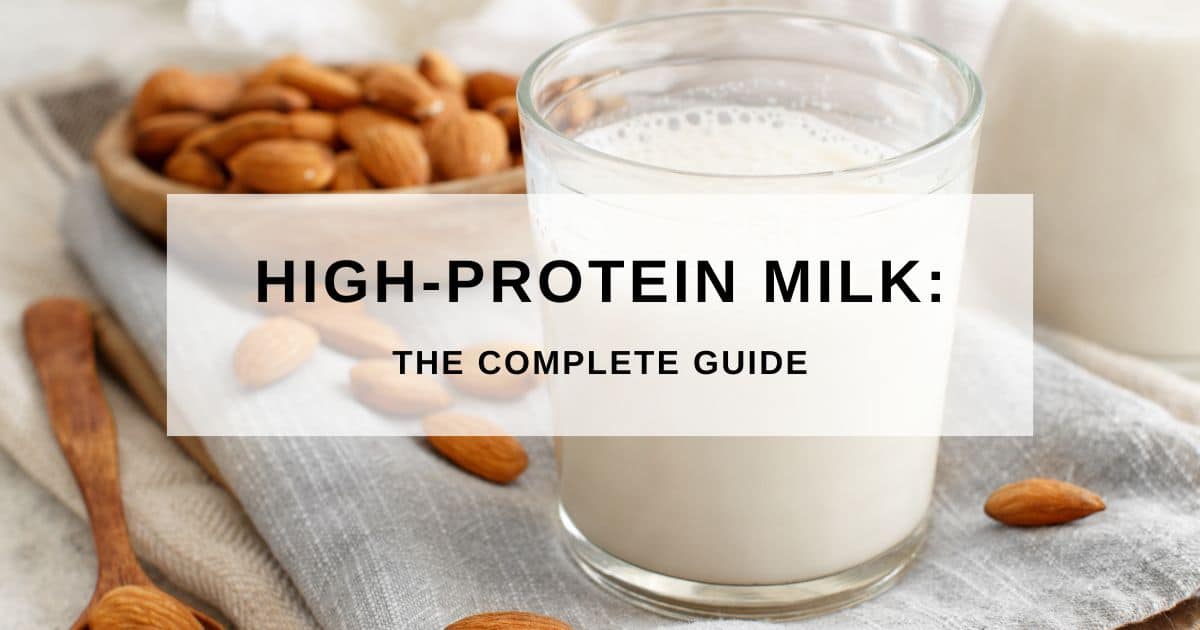Protein is an important part of a well-balanced diet and essential for nearly every process that occurs in your body. Whether you’re looking for ideas to increase your protein intake or simply interested in optimizing your nutrition, this comprehensive guide will address the protein content of foods from several categories, including meat, fish, poultry, eggs, dairy, legumes, nuts, seeds, grains, vegetables, fruits, and protein supplements.
Make sure to download our Protein Content of Foods PDF.
Importance of protein in a balanced diet
Dietary protein is important for:
- Muscle growth and strength
- Maintenance and repair of all organs, cells, and tissues
- Production of enzymes, hormones, and neurotransmitters
- Blood sugar regulation
- Digestion and absorption of nutrients
Essential amino acids & complete proteins
There are 20 standard amino acids. Your body makes 11 of these amino acids, which are called non-essential amino acids. The other 9 amino acids can only be obtained from food, and they are called essential amino acids.
Complete proteins are foods that contain all 9 essential amino acids in a high enough amount for optimal use by the body. These mainly include animal products and some soy foods. Most other plant-based foods are low in 1 or more essential amino acids and are referred to as incomplete proteins.
Incomplete proteins can be combined with other foods containing the missing amino acids to help optimize your body’s use of the amino acids. Generally, if you eat enough total protein each day, you won’t need to worry about tracking amino acids, but if you have a restricted diet or follow a vegan diet, you may want to be aware of the essential amino acids that may be low in your diet.
Protein content of foods
Food sources high in protein
While most foods contain some protein, focusing on foods high in protein can make it easier to meet your protein needs.
Foods that tend to be highest in protein per serving include meat, poultry, fish, egg whites, Greek yogurt, cottage cheese, super-firm tofu, textured vegetable protein, tempeh, seitan, and protein powder.
Protein in common foods
Below, we compare the protein content of common foods, sorted by the following categories:
- Meat, poultry, & fish
- Dairy & eggs
- Vegan meats
- Legumes
- Nuts & seeds
- Grains
- Vegetables
- Fruits
- Non-dairy milk (general options)
- Non-dairy milk (high-protein commercial options)
- Other vegan foods
- Protein powders
You can also download our free PDF reference.
| Protein Source | Serving Size | Protein (g) | Calories |
|---|---|---|---|
| Meat, Poultry, & Fish | |||
| Beef (ground, 93% lean, raw) | 4 oz | 24 | 172 |
| Beef, Ribeye (boneless, trimmed to 0″ fat, raw) | 4 oz | 25 | 156 |
| Chicken Breast (boneless, skinless, raw) | 4 oz | 25 | 136 |
| Chicken Thigh (boneless, skinless, raw) | 4 oz | 22 | 137 |
| Pork Loin Chop (boneless, raw) | 4 oz | 25 | 170 |
| Pork Shoulder (boneless, raw) | 4 oz | 24 | 145 |
| Salmon (raw) | 4 oz | 25 | 148 |
| Shrimp (raw) | 4 oz | 23 | 96 |
| Tuna (Skipjack, canned) | 4.5 oz | 36 | 150 |
| Turkey Breast (deli sliced) | 4 oz | 20 | 120 |
| Turkey (ground, 93%, raw) | 4 oz | 21 | 170 |
| Dairy & Eggs | |||
| Cheese, Mozzarella (part-skim) | 1 oz | 7 | 72 |
| Cheese, Cheddar | 1 oz | 6.5 | 114 |
| Cheese, Swiss | 1 oz | 7.5 | 110 |
| Cottage Cheese (2%) | 4 oz | 13 | 90 |
| Eggs | 1 large (50 g) | 6 | 72 |
| Egg whites | 3 Tbsp (46 g) | 5 | 25 |
| Greek Yogurt (non-fat, plain) | 5.3 oz | 18 | 110 |
| Milk (non-fat) | 8 oz | 8 | 80 |
| Ricotta Cheese (whole milk) | 4 oz | 10 | 200 |
| Vegan Meats | |||
| Beyond Meatballs | 4.3 oz | 19 | 290 |
| Gardein Black Bean Burger | 1 patty (67 g) | 9 | 170 |
| Impossible Burger Patties | 4 oz | 19 | 230 |
| Seitan (Vital Wheat Gluten) | 4 oz | 37 | 185 |
| Tempeh | 4 oz | 24 | 213 |
| Textured Vegetable Protein | 4 oz | 26 | 180 |
| Tofu (super-firm) | 4 oz | 15 | 130 |
| Legumes (Cooked) | |||
| Adzuki Beans | 1/2 cup | 8.5 | 147 |
| Black Beans | 1/2 cup | 8 | 114 |
| Black-Eyed Peas | 1/2 cup | 7 | 99 |
| Chickpea Pasta | 2 oz (uncooked) | 14 | 190 |
| Chickpeas | 1/2 cup | 7 | 134 |
| Edamame | 1/2 cup | 9 | 190 |
| Fava Beans | 1/2 cup | 6.5 | 94 |
| Hummus | 1/4 cup | 5 | 155 |
| Kidney Beans | 1/2 cup | 8 | 112 |
| Lentils | 1/2 cup | 9 | 101 |
| Mung Beans | 1/2 cup | 7 | 106 |
| Navy Beans | 1/2 cup | 7.5 | 127 |
| Peas | 1/2 cup | 4 | 59 |
| Pinto Beans | 1/2 cup | 11 | 197 |
| Soybeans | 1/2 cup | 15 | 149 |
| Nuts & Seeds (Shelled) | |||
| Almond Butter | 1 Tbsp | 4 | 100 |
| Almonds | 1 oz | 6 | 163 |
| Brazil Nuts | 1 oz | 4 | 186 |
| Cashews | 1 oz | 4 | 162 |
| Chia Seeds | 1 oz | 5 | 138 |
| Flaxseeds | 1 oz | 6 | 140 |
| Hazelnuts | 1 oz | 4 | 178 |
| Hemp Seeds (shelled) | 1 oz | 10 | 180 |
| Peanut Butter | 1 Tbsp | 4 | 95 |
| Peanuts | 1 oz | 7 | 166 |
| Pecans | 1 oz | 3 | 196 |
| Pine Nuts | 1 oz | 4 | 191 |
| Pistachios | 1 oz | 6 | 161 |
| Pumpkin Seeds | 1 oz | 9 | 159 |
| Sesame Seeds | 1 Tbsp | 1.6 | 52 |
| Sunflower Seeds | 1 oz | 6 | 140 |
| Walnuts | 1 oz | 4 | 185 |
| Grains (Cooked) | |||
| Amaranth | 1/2 cup | 2.5 | 125 |
| Bagel, White | 1 bagel (2 oz) | 5 | 150 |
| Bread, Multi-Grain | 1 slice (1 oz) | 4 | 75 |
| Brown Rice | 1/2 cup | 2.5 | 108 |
| Buckwheat Groats | 1/2 cup | 2.9 | 78 |
| Corn | 1/2 cup | 2.5 | 76 |
| Millet | 1/2 cup | 3 | 103 |
| Oats | 1/2 cup | 2.5 | 70 |
| Pasta, Whole-Grain (uncooked) | 2 oz | 7.5 | 203 |
| Quinoa | 1/2 cup | 4 | 111 |
| Rye Flakes | 1/2 cup | 4 | 98 |
| Spelt | 1/2 cup | 5 | 123 |
| Teff | 1/2 cup | 5 | 127 |
| Tortilla, Corn | 1 tortilla (19 g) | 1 | 45 |
| Tortilla, Wheat | 1 tortilla (50 g) | 6 | 130 |
| Vegetables (Cooked) | |||
| Artichoke Hearts | 1 cup | 3 | 42 |
| Broccoli | 1 cup | 4 | 54 |
| Collard Greens | 1/2 cup | 5 | 62 |
| Mushrooms | 1 cup | 3.5 | 44 |
| Spinach | 1/2 cup | 3 | 41 |
| Sweet Potato | 1 cup | 4 | 180 |
| White Potato | 1 cup | 1.5 | 57 |
| Fruit | |||
| Apricot (dried) | 1/2 cup | 2 | 157 |
| Banana | 1 cup (150 g) | 1.5 | 134 |
| Blackberries | 1 cup | 2 | 62 |
| Guava | 1 cup | 4 | 112 |
| Kiwi | 1 cup | 2 | 110 |
| Plantains (cooked) | 1 cup (140 g) | 2 | 215 |
| Non-Dairy Milk (General Options) | |||
| Almond Milk | 8 oz | 1 | 40 |
| Cashew Milk | 8 oz | 4 | 130 |
| Coconut Milk | 8 oz | 0 | 45 |
| Flax Milk | 8 oz | 3 | 50 |
| Hemp Milk | 8 oz | 3 | 60 |
| Oatmilk | 8 oz | 3 | 80 |
| Rice Milk | 8 oz | 0.5 | 115 |
| Soy Milk | 8 oz | 8 | 110 |
| Non-Dairy Milk (High-Protein Commercial Options) | |||
| Califia Farms Protein Oatmilk | 8 oz | 8 | 140 |
| Good Karma Flaxmilk + Protein | 8 oz | 8 | 70 |
| Ripple Oatmilk + Protein | 8 oz | 6 | 150 |
| Ripple Plant-Based Milk | 8 oz | 8 | 80-100 |
| Shroom Junkie Original Plantmilk | 8 oz | 10 | 140 |
| Silk Protein Nutmilk | 8 oz | 10 | 130-150 |
| Other Vegan Foods | |||
| Maca Root Powder | 1 Tbsp | 3 | 60 |
| Nutritional Yeast | 1 Tbsp | 2 | 15 |
| Seaweed (dried) | 1 oz | 5 | 68 |
| Spirulina Powder | 1 Tbsp | 5 | 25 |
| Protein Powders | |||
| Beef Bone Broth Powder | 22 g | 20 | 90 |
| Brown Rice Protein Powder | 30 g | 25 | 120 |
| Brown Rice & Pea Protein Blend | 30 g | 23 | 120 |
| Casein Protein Powder | 30 g | 26 | 110 |
| Collagen Powder (hydrolyzed) | 11 g | 10 | 40 |
| Hemp Protein Powder | 31 g | 12 | 120 |
| Milk Powder (non-fat) | 23 g | 8 | 80 |
| Pea Protein Powder | 30 g | 27 | 120 |
| Soy Protein Isolate | 19 g | 16 | 70 |
| Whey Protein Isolate | 30 g | 26 | 110 |
Tips for calculating the protein content of foods
If you need more specific nutrition information for certain foods, you can also reference the nutrition label, online databases (like USDA FoodData Central, Nutritionix, My Food Data, or FoodStruct), and mobile apps (like Cronometer or My Fitness Pal).
For the best accuracy in tracking protein in foods, be sure you are using the correct version of the food (i.e. raw, cooked, fried, dried, etc.). Weighing food on a scale using grams also helps with accuracy.
Balancing protein in a healthy diet
A healthy diet includes all three macronutrients (protein, carbohydrates, and fat), along with vitamins and minerals. When determining your individual macronutrient needs, it’s helpful to first calculate your protein needs. Most adults benefit from 1.2-2 g/kg body weight of protein per day, but you can find more specific recommendations in our article, Recommended Protein Intake.
More resources
- What is Protein?
- What Are Amino Acids?
- Recommended Protein Intake
- Tofu vs Chicken
- Peanut Butter Powder Nutrition
- High-Protein Milk
- High-Protein Vegan Snacks
- Vegan Protein Sources Chart (Free PDF)
Want to save this article? Click here to get a PDF copy delivered to your inbox (a link to our Protein Content of Foods PDF is included).
This page may contain affiliate links. If you choose to purchase after clicking a link, I may receive a commission at no extra cost to you.
Collette is a registered dietitian and has over a decade of experience working with athletes, children & adults on tube feeding, and people with chronic health conditions. She has been writing about food and nutrition since she was in high school and has a passion for sharing evidence-based information, especially on the topics of protein and the importance of maintaining muscle mass for healthy aging.




